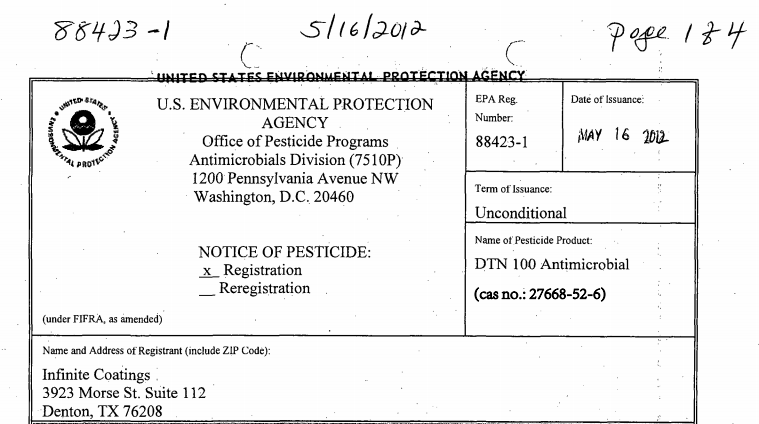DTN 100 Antimicrobial,CAS number 27668-52-6
ACTIVE INGREDIENT: 3-(trimetholxysilyl) propyldimethyloctadecyl Ammonium chloride 72%
INERT INGREDIENTS 28% (CONTAINS OVER 12% Methanol)
Synonyms:
Silane Quat,Quat Silane,SiQAC,SiQuat,Si-Quat,A Silicone Quaternary Ammonium Salt,3-(Trimethoxysilyl)propyl dimethyl octadecyl ammonium chloride,3-(Trimethoxysilyl)propyldimethyl octadecyl ammonium chloride,3-(Trimethoxysilyl)propyldimethyloctadecyl ammonium chloride,3-(Trimethoxysilyl) propyldimethyloctadecyl ammonium chloride
Registered by Infinite Coatings with EPA Reg No 88423-1
DTN 100 Antimicrobial, cas: 27668-52-6 (A Silicone Quaternary Ammonium Salt) is a known antimicrobial that provides long-lasting protection against odor causing bacteria, toxic mold, fungi and other harmful microbes.
PRODUCT FEATURES AND BENEFITS of DTN 100 Antimicrobial,cas:27668-52-6
DTN 100 Antimicrobial imparts durable biostatic activity to the surface of a wide variety of substrates. DTN 100 Antimicrobial is effective against mold, mildew and algae as a static agent. Increased efficiency-through proper
application, durable bacteriostatic, fungistatic and algistatic surfaces can be attained with a minimum amount of DTN 100 Antimicrobial. Provides freshness and combats deterioration and discoloration caused by bacteria, fungi and algae
DIRECTIONS FOR USE of DTN 100 Antimicrobial,cas:27668-52-6:
It is a violation of Federal Law to use this product in a manner inconsistent with its label.
FOR INDUSTRIAL USE ONLY. This product is registered for formulation into Antimicrobial Products or as a microbiostatic agent for material preservation; neither this product nor the articles treated with this product may state or imply
any public health claims. Articles or substances treated with this product will be exempt from FIFRA regulation pursuant to 40 CFR 152.25(a) if the intended use for incorporating this material into a treated article or substance is for
the protection of the article or substance itself.
APPROVED USES: DTN 100 Antimicrobial manufactured products listed below for use in industrial, institutional, commercial or residential locations for non-food contact uses.
Plastics, fiberglass, metals, glass, wood, ceramics, stone, natural materials, composites: Including air filters for furnaces, air conditioners, air purification devices, automobiles, and recirculating air handling systems; aquarium filters; automotive and vehicular parts; roofing materials (tiles, shakes, shingles, granules, stone, membranes, felt, underlayment and synthetic overcoats); building materials and components (including siding, wallboard, wood and wood
composites, insulation and on-food contact cabinetry); ceiling tiles; concrete products; paints and coatings; mastics and sealants; cementitious materials (including caulk, grout and cement and grout premixes); non-food contact conveyor and humidifier belts; non-food contact countertops; fiberglass ductboard for air handling systems; floor covering; flooring; general purpose (non-food contact) containers; furniture; bathroom and non-food contact kitchen hardware; mats; plumbing supplies and fixtures; sheet and formed glass; non-food contact sponges and mops; vacuum cleaner bags and filters; foam for packaging and cushioning in non-food applications.
Fibers, fabrics (natural and synthetic, woven and on-woven), leather and household materials (natural and synthetic):
Including buffer pads (abrasive and polishing); mattress cover pads, filling and ticking; pillow covers; sheets; blankets; bedspreads; fiberfill for upholstery, recreational gear, quilts and pillows; curtains; draperies; carpet and
carpet underlay; rugs; upholstery; towels; shower curtains; toilet tank and seat covers; wall covering fabrics and wallpaper (including vinyl) for non-food contact surfaces; umbrellas; fire hose fabric; non-woven disposable diapers;
wiping cloths; pre-moistened towelettes and tissue wipes (these do not impart pesticidal properties); apparel, including outerwear, sportswear, sleepwear, socks, hosiery, undergarments, gloves and uniforms; footwear (boots, shoes and
components); sports equipment and athletic gear; cloth for sails, ropes, tents
and other outdoor equipment; sand bags; tarps; awnings; file folders and binder covers; book covers; pictures.
Miscellaneous Manufactured Products: disposable foam cushions for Lapidus Airfloat Systems; foam used as a growth medium for non-food crops and plants.
Do not contaminate water, food, or feed by storage and disposal.
STORAGE: Store in original, tightly closed container in an area inaccessible to children or persons unfamiliar with its use. Moisture sensitive. Keep tightly closed until ready to use. Reclose tightly after each use. When stored in
original, unopened container at or below 25°C, DTN 100 Antimicrobial has a shelf life of 12 months from date of shipment
Safety of DTN 100 Antimicrobial,cas:27668-52-6:
KEEP OUT OF REACH OF CHILDREN
FIRST AID
If inhaled:
• Move person to fresh air
• If person is not breathing, call 911 or ambulance, then give artificial respiration, preferably by mouth-to-mouth, if possible.
• Call a Poison Control Center or doctor for treatment advice.
If in the eyes:
• Hold eye open and rinse slowly and gently with water for 15-20 minutes.
• Remove contact lenses, if present, after first 5 minutes, then continue rinsing.
• Call a Poison Control Center or doctor for treatment advice.
If in skin or clothing:
• Take off contaminated clothing.
• Rinse skin immediately with plenty of water for 15-20 minutes.
• Call a Poison Control Center or doctor immediately for treatment advice.
If swallowed:
• Call a Poison Control Center or doctor immediately for treatment advice.
• Have person sip a glass of water if able to swallow.
• Do not induce vomiting unless told to do so by a Poison Control Center or doctor.
• Do not give anything by mouth to an unconscious person.

